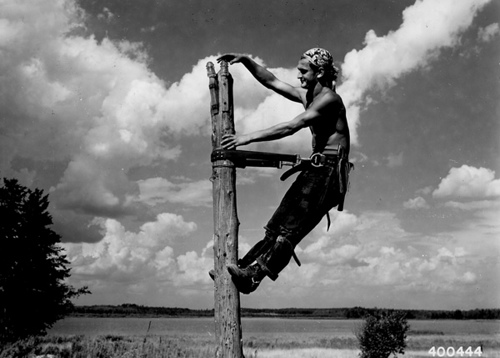
There are millions of unemployed ready to go to work today. The only missing element is someone to hire them.
Since private industry isn’t hiring, where will jobs come from? What did the country do during the Great Depression?
In the 1930s the New Deal put construction workers on the job building infrastructure we have used ever since. Much of that network is at the end of its life, so let’s do it again, but this time with “green” planning built in.
In the 1930s artists were unemployed. The New Deal hired them and they gave us the fantastic murals, mosaics and monuments in our public places. We could use a lot more of them.
Planting all those trees in our national forests and parks, and building all those lodges, cabins and trail shelters in state and national parks and elsewhere was a good idea. Only thing is, we need more of them.
Under the New Deal the Federal Writers Project subsidized play and book writing and all kinds of other literary pursuits. Advertising people and writers of all kinds are out of work today.
In the 1930s white collar workers with college degrees were unemployed. The New Deal hired many of them into the regulatory bodies it set up to control the worst excesses of capitalism and to regulate private industry. Hiring some of our college graduates to do this again, today, seems like a worthwhile idea. It certainly beats sending them to Wall Street where they work on devising methods that ruin both the economy and eventually, their own livelihoods.
But to win the old New Deal, it took a fight. It’s going to take the same thing to win a new New Green Deal.
Photo: National Archives http://www.flickr.com/photos/32912172@N00/ / CC BY 2.0
When FDR took office, he immediately commenced a massive revitalization of the nation’s economy. In response to the depression that hung over the nation in the early 1930s, President Roosevelt created many programs designed to put Americans back to work.
In his first 100 days in office, President Roosevelt approved several measures as part of his “New Deal,” including the Emergency Conservation Work Act (ECW), better known as the Civilian Conservation Corps (CCC). With that action, he brought together the nation’s young men and the land in an effort to save them both. Roosevelt proposed to recruit thousands of unemployed young men, enlist them in a peacetime army, and send them to battle the erosion and destruction of the nation’s natural resources.
The CCC, also known as Roosevelt’s Tree Army, was credited with renewing the nation’s decimated forests by planting an estimated three billion trees from 1933 to 1942. This was crucial, especially in states affected by the Dust Bowl, where reforestation was necessary to break the wind, hold water in the soil, and hold the soil in place. So far reaching was the CCC’s reforestation program that it was responsible for more than half the reforestation, public and private, accomplish in the nation’s history.
Eligibility requirements for the CCC carried several simple stipulations. Congress required U.S. citizenship only. Other standards were set by the ECW. Sound physical fitness was mandatory because of the hard physical labor required. Men had to be unemployed, unmarried, and between the ages of 18 and 26, although the rules were eventually relaxed for war veterans. Enlistment was for a duration of six months, although many reenlisted after their alloted time was up.
Problems were confronted quickly. The bulk of the nation’s young and unemployed youth were concentrated in the East, while most of the work projects were in the western parts of the country. The War Department mobilized the nation’s transportation system to move thousands of enrollees from induction centers to work camps. The Agriculture and Interior departments were responsible for planning and organizing work to be performed in every state. The Department of Labor was responsible for the selection and enrollment of applicants. The National Director of the ECW was Robert Fechner, a union vice president chosen personally by President Roosevelt.
Young men flocked to enroll. Many politicians believed that the CCC was largely responsible for a 55 percent reduction in crimes committed by the young men of that day. Men were paid $30 a month, with mandatory $25 allotment checks sent to families of the men, which made life a little easier for people at home.
Camps were set up in all states, as well as in Hawaii, Alaska, Puerto Rico, and the Virgin Islands. Enrollment peaked at the end of 1935, when there were 500,000 men located in 2,600 camps in operation in all states. California alone had more than 150 camps. The greatest concentration of CCC personnel was in the Sixth Civilian Conservation Corps District of the First Corps Area, in the Winooski River Valley of Vermont, in December 1933. Enlisted personnel and supervisors totaled more than 5,300 and occupied four large camps.
The program enjoyed great public support. Once the first camps were established and the CCC became better known, they became accepted and even sought after. The CCC camps stimulated regional economies and provided communities with improvements in forest activity, flood control, fire protection, and overall community safety.
Although policy prohibited discrimination, blacks and other minorities encountered numerous difficulties in the CCC. In the early years of the program, some camps were integrated. By 1935, however, there was, in the words of CCC director Fechner, a “complete segregation of colored and white enrollees,” but “segregation is not discrimination.” At its peak, more than 250,000 African Americans were enrolled in nearly 150 all-black CCC companies.
An important modification became necessary early in 1933. It extended enlistment coverage to about 14,000 American Indians whose economic circumstances were deplorable and had mostly been ignored. Before the CCC was terminated, more than 80,000 Native Americans were paid to help reclaim the land that had once been theirs.
In addition, in May 1933, the president authorized the enrollment of about 25,000 veterans of the Spanish American War and World War I, with no age or marital restrictions. This made it possible for more than 250,000 veterans to rebuild lives disrupted by earlier service to their country.
In June 1933, the ECW decided that men in CCC camps could be given the opportunity of vocational training and additional education. Educational programs were developed that varied considerably from camp to camp, both in efficiency and results. More than 90 percent of all enrollees participated in some facet of the educational program. Throughout the CCC, more than 40,000 illiterate men were taught to read and write.
By 1942, there was hardly a state that could not boast of permanent projects left as markers by the CCC. The CCC worked on improving millions of acres of federal and state lands, as well as parks. New roads were built, telephone lines strung, and trees planted.
CCC projects included:
# more than 3,470 fire towers erected;
# 97,000 miles of fire roads built;
# 4,235,000 man-days devoted to fighting fires;
# more than 3 billion trees planted;
# 7,153,000 man days expended on protecting the natural habitats of wildlife; 83 camps in 15 Western states assigned 45 projects of that nature;
# 46 camps assigned to work under the direction of the U.S. Bureau of Agriculture Engineering;
# more than 84,400,000 acres of good agricultural land receive manmade drainage systems; Indian enrollees do much of that work;
# 1,240,000 man-days of emergency work completed during floods of the Ohio and Mississippi valleys;
# disease and insect control;
# forest improvement – timber stand inventories, surveying, and reforestation;
# forest recreation development – campgrounds built, complete with picnic shelters, swimming pools, fireplaces, and restrooms.
In addition, 500 camps were under the control of the Soil Conservation Service. The primary work of those camps was erosion control. The CCC also made outstanding contributions to the development of recreational facilities in national, state, county, and metropolitan parks. By design, the CCC worked on projects that were independent of other public relief programs. Although other federal agencies, such as the National Park Service and Soil Conservation Service contributed, the U.S. Forest Service administered more than 50 percent of all public work projects for the CCC.
Residents of southern Indiana will always remember the extraordinary work of the CCC during the flood of the Ohio River in 1937. The combined strength of the camps in the area saved lives as well as property. The CCC also was involved in other natural disasters, including a hurricane in New England in 1938, floods in Vermont and New York, and blizzards in Utah.
The Civilian Conservation Corps was one of the most successful New Deal programs of the Great Depression. It existed for fewer than 10 years, but left a legacy of strong, handsome roads, bridges, and buildings throughout the United States. Between 1933 and 1941, more than 3,000,000 men served in the CCC.
The effects of service in the CCC were felt for years, even decades, afterwards. Following the depression, when the job market picked up, businessmen indicated a preference for hiring a man who had been in the CCC, and the reason was simple. Employers believed that anyone who had been in the CCC would know what a full day’s work meant, and how to carry out orders in a disciplined way.
Today, many of the remaining physical features the CCC built have been placed on the National Register of Historic Places.












Comments